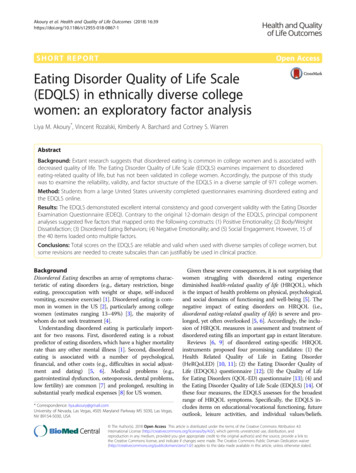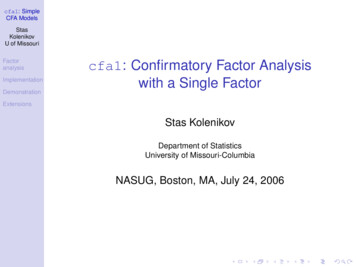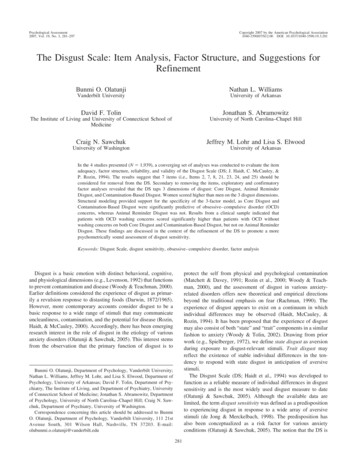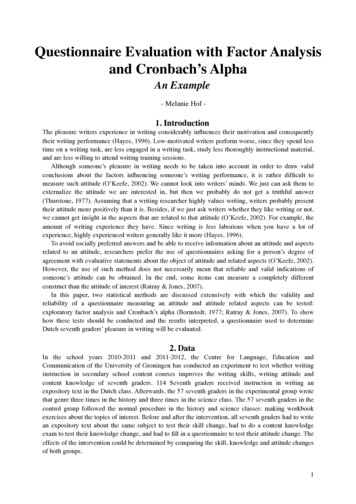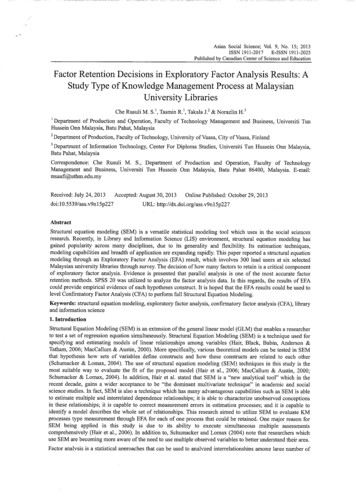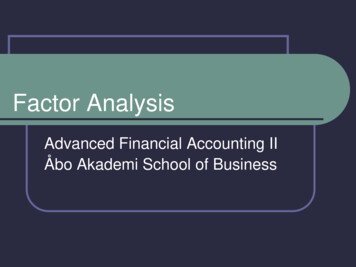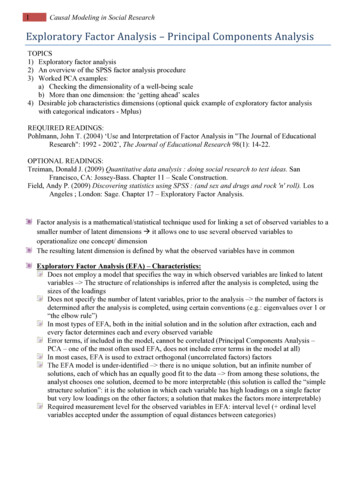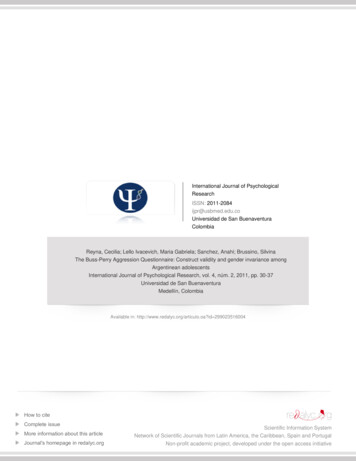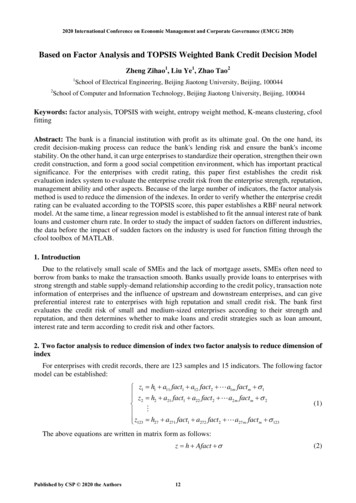
Transcription
2020 International Conference on Economic Management and Corporate Governance (EMCG 2020)Based on Factor Analysis and TOPSIS Weighted Bank Credit Decision ModelZheng Zihao1, Liu Ye1, Zhao Tao21School of Electrical Engineering, Beijing Jiaotong University, Beijing, 1000442School of Computer and Information Technology, Beijing Jiaotong University, Beijing, 100044Keywords: factor analysis, TOPSIS with weight, entropy weight method, K-means clustering, cfoolfittingAbstract: The bank is a financial institution with profit as its ultimate goal. On the one hand, itscredit decision-making process can reduce the bank's lending risk and ensure the bank's incomestability. On the other hand, it can urge enterprises to standardize their operation, strengthen their owncredit construction, and form a good social competition environment, which has important practicalsignificance. For the enterprises with credit rating, this paper first establishes the credit riskevaluation index system to evaluate the enterprise credit risk from the enterprise strength, reputation,management ability and other aspects. Because of the large number of indicators, the factor analysismethod is used to reduce the dimension of the indexes. In order to verify whether the enterprise creditrating can be evaluated according to the TOPSIS score, this paper establishes a RBF neural networkmodel. At the same time, a linear regression model is established to fit the annual interest rate of bankloans and customer churn rate. In order to study the impact of sudden factors on different industries,the data before the impact of sudden factors on the industry is used for function fitting through thecfool toolbox of MATLAB.1. IntroductionDue to the relatively small scale of SMEs and the lack of mortgage assets, SMEs often need toborrow from banks to make the transaction smooth. Banks usually provide loans to enterprises withstrong strength and stable supply-demand relationship according to the credit policy, transaction noteinformation of enterprises and the influence of upstream and downstream enterprises, and can givepreferential interest rate to enterprises with high reputation and small credit risk. The bank firstevaluates the credit risk of small and medium-sized enterprises according to their strength andreputation, and then determines whether to make loans and credit strategies such as loan amount,interest rate and term according to credit risk and other factors.2. Two factor analysis to reduce dimension of index two factor analysis to reduce dimension ofindexFor enterprises with credit records, there are 123 samples and 15 indicators. The following factormodel can be established:h1 a11 fact1 a12 fact2 a1m factm σ 1 z1 z 2 h2 a21 fact1 a22 fact2 a2 m factm σ 2 z123 h27 a271 fact1 a272 fact2 a27 m factm σ 123(1)The above equations are written in matrix form as follows:z h Afact σPublished by CSP 2020 the Authors12(2)
3. Determining weight vector of virtual index by entropy weight methodThe index weight determined by AHP is very subjective, so we choose entropy weight method toweight the six virtual weights obtained above, and the positive matrix is as follows: f11 fF 21 f1231 f12f 22 f1232 f1236 f16f 26 (3)3.1 Normalization of positive matrixNormalize the positive matrix, and mark the standardized matrix as to judge whether there is anegative number in the matrix. If there is a negative number, it needs to be standardized once toensure that every element in the matrix is non negative. The formula is as follows:t ik fik min{ f1k , f 2 k , f123k }max{ f1k , f 2 k , f123k } min{ f1k , f 2 k , f123k }(4)3.2 Calculate the entropy weight of each indexFor the kth index, its information utility value is equal to:1ln 6n1 1, 2, 6)τk pik ln( pik )(k (5)i 1The entropy weight of each index can be obtained by normalizing the information utility value6 ωk τ 1, 2, , 6)k τ k (k(6)k 1Using MATLAB to calculate the weight vector of the virtual index ω (0.066, 0.007, 0.132, 0.006, 0.007, 0.782)It is the score matrix of 123 enterprises with credit records calculated by TOPSIS model optimizedby entropy weight method, and the amount of bank loans is allocated proportionally according to thescores of each enterprise.4. Evaluation of reputation grade by RBF neural network modelRBF (radial basis function) neural network model is a three-layer forward network, which iscomposed of input layer, hidden layer and output layer. The neural cells in the hidden layer are basedon the nonlinear radial function, and the vector input is not connected according to the weight, butdirectly transmitted to the corresponding space. The output of the hidden layer neural cells isweighted sum to obtain the linear output of the neural network. The essence of RBF neural network isto transform the input data from one space to another. Through spatial transformation, the input datais transformed from non-linear to linear, and the complex problems become easy to solve .For the layer (hidden layer), the output value of the node is:og g ( scorei )(7)Where G is the activation function of hidden layer node. Here we select soft max function, that is:g ( scorei ) exp( scorei )123 exp(score )i 113i(8)
For the layer (output layer), the output value of the node is:oρ h(netθ )(9)H is the activation function of the output layer node.The error between the predicted credit rating and the actual credit rating calculated by SPSS isshown in Table 1: the percentage of incorrect prediction is 0, that is, the predicted result is basicallyconsistent with the actual result. Therefore, the TOPSIS score model constructed above can be usedfor corporate reputation rating.Table 1 Surface Prediction error of RBF neural networkSum of squares error1.194E-27Percentage of incorrect predictions0%trainBayesian information criterion (BIC)training time.a0:00:00.315. Relationship between annual interest rate of bank loans and customer churn rateBoth commercial banks and enterprises are profit-making institutions. The determination of theannual interest rate of bank loans is one of the key factors for banks to reduce credit risk and obtainsatisfactory returns. Establishing the functional relationship between the annual interest rate of bankloans and the rate of customer churn is of great reference significance to the formulation of Bankcredit strategy. According to the statistical data of the relationship between customer churn rate andannual interest rate of bank loans in 2019, the scatter diagram is shown in Figure 1Figure 1 Scatter chart of the relationship between customer churn rate and annual interest rate of bankloansIt can be seen from the scatter chart that there is an obvious linear relationship between thecustomer churn rate and the annual interest rate of bank loans, so we establish a linear regressionmodel to analyze it.The annual interest rate of the bank loan of the third enterprise with credit record is𝛼𝛼𝑖𝑖 .Thecorresponding customer churn rate is𝑓𝑓𝑖𝑖 .The relationship between the customer churn rate and theannual interest rate of the loan meets the following requirements:4Tfi λ µα i ε iWhen14(10)
123123123 i 1 i 1 i 1)2 ( fi fˆi ˆ i ) 2 min ( fi λ mα i ) 2 ( fi λˆ mα(11)The residual error is the minimum.123123ˆ ii ) 2 )Hereare: λˆ, mˆ arg min( ( fi fˆi ) 2 ) arg min( ( fi λˆ maλ ,mλ ,m i 1 i 1123ˆ arg min( ( ˆ i ) 2 )λˆ, mmλ ,m(12)i 1The data were analyzed by SPSS and the following conclusions were obtained 0.098 7.524α fA f B 0.118 7.351αf 0.138 7.468α fC f D 1(13)among𝑓𝑓𝑘𝑘 (𝛼𝛼) It is the functional relationship between the customer churn rate of enterprises withcredit rating (k a, B, c) and the annual interest rate of bank loans.4T6. Optimization model for solving annual loan interest rate6.1 Establishment of optimization modelThe annual interest rate of bank loan is closely related to the bank & apos; s income this year. Fromthe perspective of the bank, it is necessary to ensure that the bank can obtain as much revenue aspossible when determining the annual interest rate of bank loan. Therefore, the problem of solving theannual interest rate of loan can be transformed into the optimization problem of maximizing the bank& apos; The decision variable is the annual interest rate of the third enterprise with credit record. Ifthe annual income function of the bank is, then the objective function is: IQmax Q [1 f (aa)] score′ N(14)Where is the function of customer churn rate on the loan annual interest rate, is the normalizedenterprise score, and is the total credit. Because it is a constant, it does not affect the solution of theobjective function, so that 1 can simplify the objective function. The constraints to be satisfied arethe range of annual interest rate of bank loans and the normalization of scores. 4% α i 15% 123 score′ 1 i 1(15)6.2 Creative transformation of solutionConsidering that different regression equation coefficients are needed when the credit rating ofenterprises is different, which hinders lingo & apos; solution, we transform the piecewise solvingproblem into a matrix operation solving problem.If a coefficient matrix of 4 1 is constructed, then M T [7.524, 7.531, 7.468, 0]f L M(16)Matlab is used to calculate the matrix, and lingo is used to optimize the solution to get the annualloan interest rate of each enterprise when the bank & apos; annual income is maximized. Theenterprise with the annual interest rate of 15% does not lend by default.15
7. ConclusionLess than zero in industry, retail, catering, logistics and transportation, medical and health industry,and humanities industry, indicating that the new epidemic had a negative impact on these industries.During the epidemic period, in order to effectively control the spread of the virus, most enterprisesshut down production except for medical devices, pharmaceuticals, mask production and necessarylogistics transportation. The frequency of people dining out suddenly dropped and the cateringindustry suffered huge losses. Most of the materials are transported by means of transportation andtransportation routes designated by the state. The expenses for medical treatment and isolation ofpatients with fever are subsidized by the state, and the implementation of home isolation measuresreduces the spread of other influenza. Therefore, the logistics and transportation industry, medicaland health industry, etc., also have a certain "negative growth". However, the promotion of cloudoffice, online doctor consultation and online courses has promoted the development of high-techindustry to a certain extent, and the total industrial output value has a greater growth rate.References[1] Wei Xiao. Research on credit decision of commercial banks for SMEs [D]. Shandong Universityof Finance and economics, 020.tax(VAT),[3] Di Zhang ying. Research and application of SME bank loan decision model [D]. Shanghai Jiaotong University, 201416
2. Two factor analysis to reduce dimension of index two factor analysis to reduce dimension of index. For enterprises with credit records, there are 123 samples and 15 indicators. The following factor model can be established: 1 1 11 1 12 2 1 1 2 2 21 1 22 2 2 2 123 27 271 1 272 2 27 123. mm mm mm. z h a fact a fact a fact z h a fact a fact a fact
